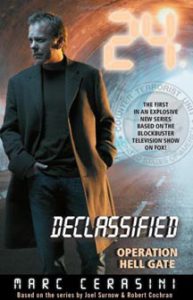When a TV series becomes popular, almost without exception, the spinoff materials follow. “24’s” concept was uniquely suited to TV, since the number of hours in a day corresponds closely to the number of episodes in a season. Four years after its TV debut, it transitioned to novels, and right out of the gate (no pun intended), “24” showed it works in that format too with Marc Cerasini’s “Operation Hell Gate” (2005).
It’s the first of what would be 11 novels under the “Declassified” banner. These missions – wherein each chapter represents one hour of a day — happen between the founding of CTU in the wake of the 1993 World Trade Center bombing and the 2001-set Day 1. Based on context clues such as CTU examining documents from 1996, Jack stating that Kim is almost a teenager and Chappelle noting that CTU is less than five years old, I guessed “Operation Hell Gate” takes place in 1997; the “24” Wiki officially places it in 1998.
Cerasini is presented with a seemingly tricky task, because this mission can’t be “bigger” than Day 1, which Jack laments in a voiceover is “the longest day of my life.” But it’s not too challenging, because the very nature of the medium makes these adventures “smaller.” The jumps in time here are wider gulfs than a commercial break, and a reader feels like they’re getting a thinner story.
But not a bad one; just a more focused one. In “Operation Hell Gate,” Jack and CTU must track down the terrorists who aim to set up a missile launcher at a New York City airport, where they will shoot down a plane carrying an old influenza virus against which there is no cure, thus wiping out the Big Apple (which would later be the setting of Season 8, in 2010). As is too often the case with “24” baddies, the mix of Northern Irish and Afghani villains telegraph their plan, in this case with a test firing at LAX. This triggers the attention of CTU, which then proceeds to use its high technology and brilliant analysists to follow the clues and stop the grand scheme 24 hours later (with Jack, naturally, doing the field work).
Cerasini’s biggest accomplishment is getting the mannerisms and cadences of our favorite players right — things like Tony pulling a colleague aside and speaking quietly. It’s an arguably shallow approach – Cerasini perhaps just described what he saw on TV – but it works, and it makes the appearances of Tony, Jamey, Milo, Ryan Chappelle and Richard Walsh more than mere name drops; they feel like they do on TV. (In the category of actual name drops, we get Curtis Manning and Bill Buchanan, major characters from later in the TV series. Manning is supposedly already at CTU LA, while Buchanan is at the Seattle branch.)
Nina is an interesting case. Cerasini doesn’t flat-out state that Nina is a mole at this point, but she does act shifty. In one instance, Jack is surprised that Nina doesn’t warn him that Chappelle is on the phone line with them. I think we’re supposed to conclude that Nina is playing a long con, establishing herself at CTU by truly being good at her job, but occasionally trying little things (without exposing herself) that might hurt the careers of people she sees as threats.

All of Cerasini’s newly invented characters feel like “Star Trek” red shirts. Sometimes it is blatantly obvious they will be killed off, because we’ve never heard of them before and they aren’t given any characterization. But he also gives us some well-drawn newcomers. At CTU, this includes wunderkind Doris, who is so good at computer code hacking that no one reprimands her for walking around the offices barefoot (if she had been a TV character, I suspect she would’ve been popular), and Marine Captain Jessica Schneider, who quickly hits it off with Tony.
In New York, Jack catches on with a tired and bedraggled bar waitress named Caitlin and her younger brother, Liam, whom she is trying to support. Unwittingly, the siblings are caught up in delivering a computer part for the missile launcher.
Many threads make for page-turners, but not payoffs. For example, Milo often talks on the phone to his needy girlfriend, Tina, who is frustrated that he is stuck at work. A reader braces for Tina to come into the story in person, perhaps becoming a hostage or being revealed as someone who is fishing for information from Milo. That never happens; in fact, the status of the relationship isn’t even addressed at book’s end. (Of course, there’s no reason why it should reach a conclusive point in one day’s time; still, it makes for an unsatisfying arc.)
“Operation Hell Gate” illustrates how CTU is the Little Agency That Could in the early days. It hasn’t yet proven itself, and indeed, the FBI actively withholds information, forcing CTU to hack the FBI’s system. Jack’s reputation as someone prone to going rogue is in place – although it’s propped up by a wrongful accusation by evil FBI Agent Hensley – as is Chappelle’s tendency to not support Jack if the office politics trend against him.
The novel bounces between LA and NYC, but the LA stuff is entirely at CTU, so the Big Apple provides the evocative settings, including a bar in a run-down part of town under an aboveground train rail. The story ends on the catwalks of the Hell Gate Bridge, beneath which are lethal roiling waters. (As such, we don’t learn the title’s meaning until the final pages.)
It’s a great setting for the conclusive action. But the mysteries and the investigations are wrapped up a bit too early, so the final chapters are mostly Jack being Jack — killing the bad guys and wrapping up the case. “Operation Hell Gate” feels like a legitimate “24” adventure when you’re reading it, but it ultimately doesn’t leave much of an impression.

